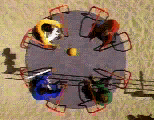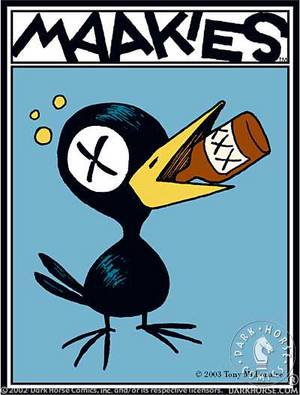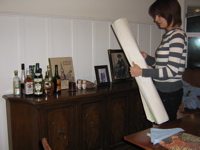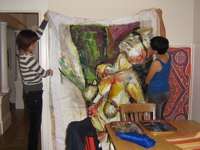The mysterious Coriolis force
 I remember the term “Coriolis force” from some ancient high school physics class, I think. But when Joe P showed us this phenomenon again in class last week, I could swear I’ve never ever thought about it before. It’s a little baffling to me at the moment (and therefore worth thinking about!).
I remember the term “Coriolis force” from some ancient high school physics class, I think. But when Joe P showed us this phenomenon again in class last week, I could swear I’ve never ever thought about it before. It’s a little baffling to me at the moment (and therefore worth thinking about!).
Compare the simple video on the Coriolis force Wikipedia page with the merry-go-round video on this page. Now figure out how cyclone winds rotate along the Earth’s surface… and you’re all set!
What is a nor’easter
 Apparently I missed another “nor’easter” last weekend while I was off in sunny, life-warming California. I thought a nor’easter was just a storm in the northeastern US. The trusty Wikipedia tells me not only what a nor’easter is, but also has a whole page devoted to the storm Boston just had.
Apparently I missed another “nor’easter” last weekend while I was off in sunny, life-warming California. I thought a nor’easter was just a storm in the northeastern US. The trusty Wikipedia tells me not only what a nor’easter is, but also has a whole page devoted to the storm Boston just had.
A nor’easter … is a macro-scale storm whose winds come from the northeast, especially in the coastal areas of the Northeastern United States and Atlantic Canada. More specifically, it describes a low pressure area whose center of rotation is just off the coast and whose leading winds in the left forward quadrant rotate onto land from the northeast. The precipitation pattern is similar to other extratropical storms. They also can cause coastal flooding, coastal erosion and gale force winds.
I missed the last listed nor’easter (November 2006) while I was in St. Louis. And last month, while I was in Seattle, I missed another storm. Is coincidence??
Drinky Crow show
 The Drinky Crow Show is joining the Adult Swim line-up on Sunday, May 13, 2007. I just marked my calendar. Happy Mother’s Day for everyone!
The Drinky Crow Show is joining the Adult Swim line-up on Sunday, May 13, 2007. I just marked my calendar. Happy Mother’s Day for everyone!
I love Tony Millionaire‘s comics because they are so pretty and clean, yet raw in the way that a detailed woodblock print is raw. And such magical language! …like something you might expect from a sophisticated pirate. Some words you would easily find in his Sock Monkey comic: delirium, syphilis, jaundice, anguish, furnace, curtailed, hideous spectre, jabbering, Blast!, doggedness, romantical.
How to keep bananas ripe
I eat a banana every day, and I am always trying to optimize the combination of ripeness of the bananas that I buy. I often buy a couple of totally yellow ones, along with a few green ones for after I’ve eaten the yellow ones. But I totally misjudge them sometimes and end up eating a brown mush, or a hard, almost bitter thing that I can hardly get the skin off of.
Below, I’ve copied some snippets of info I found on ripening fruits. A lot of people know this stuff already, but I didn’t think to keep bananas in the fridge, and I can never remember which fruits continue ripening (i.e., which ones you can still have hope for) and which ones are WYSIWYG.
From Why do some fruit ripen only on the tree and others ripen only after they are picked?:
Bananas when harvested mature have very high levels of starch (like a potato). During ripening this starch is converted to soluble sugars and that is why they taste sweeter when they are ripe. The hormone ethylene is normally used to trigger ripening in bananas (and also avocados) by applying ethylene gas into a ripening room for a period of time. The application of ethylene gas helps to reduce fruit to fruit variability in ripening time as well shortening the overall ripening time.
The avocado and banana are classified as climacteric fruits whereas the pineapple is classified as a nonclimacteric fruit. Nonclimacteric fruit do not exhibit the increase in respiration nor the rise in ethylene production nor do they normally undergo dramatic changes (such as softening) after harvest.
(from Howstuffworks “Health Benefits of Fruits…”)
Fruits that will continue to ripen [climacteric]:
- Apricots
- Avocados
- Bananas
- Cantaloupe
- Kiwi
- Nectarines
- Peaches
- Pears
- Plums
- Tomatoes
Fruits to buy ripe and ready to eat [nonclimacteric]:
- Apples
- Cherries
- Grapefruit
- Grapes
- Lemons
- Limes
- Oranges
- Pineapple
- Strawberries
- Tangerines
- Watermelon
From “Fruit Ripening”:
How can you assist fruit ripening? First let me tell you that bananas are shipped to the US as hard, green, sour, unripened fruits. They ship better that way. They arrive into a distributor’s warehouse without bruises. The bananas are put in a room and gassed with ethylene. They all begin to ripen. You buy them at the store and within a few days the ripening process is so rapid that the bananas are “over the hill” before you can eat them all.
By the way, you can allow the bananas to ripen to the stage you like them and then put them in the refrigerator. This slows the ripening process down drastically. For several days after that you can take bananas from the refrigerator and enjoy the fruit inside. Please note: the skin will turn very dark in color after only a short time in the refrigerator…you can ignore that…the fruit inside remains just as it was before you put the banana into the refrigerator.
The ripening bananas produce so much ethylene that you can use them as a tool to ripen other fruits. Take those green pears home and put them on the shelf in a paper bag with a banana. The banana at room temperature produces ethylene that will signal the green pears to start ripening immediately. The paper bag holds the ethylene in stagnant air around the fruits, yet allows oxygen to go into the bag for respiration in the fruits…needed to make the enzymes! In just a few days the pears should be ready to eat! You can do the same with avocados.
Hearing the Escher staircase
 You know this staircase, right?
You know this staircase, right?
In class, we heard the auditory analog of this visual illusion: the “Shepard-Risset glissando”, named after the two guys who worked on it. [sound sample]
The trick here is that the sound contains four notes all an octave apart, with the loudness of each note sneakily adjusted as the pitch of the notes climbs.
To understand this trick better, here’s a good visualization and demo of the discrete Shepard scale:
Visualization of the Shepard Effect
Much more discussion of how it all works on the Shepard tone Wikipedia page, which includes another sound sample of the glissando…
An independently discovered version of the Shepard tone appears at the beginning and end of the 1976 album A Day At The Races by the band Queen. The piece consists of a number of electric-guitar parts following each other up a scale in harmony, with the notes at the top of the scale fading out as new ones fade in at the bottom. Lose Control by Missy Elliott also seems to feature an ascending Shepard tone as a recurring theme (via the sampled synthesizers from Cybotron’s song “Clear”.) “Echoes”, a 23-minute song by Pink Floyd, concludes with a rising Shepard tone.
Found Art
My sister, a PhD student at UC Berkeley, has just found an interesting item tucked in the back of a drawer in her recently-purchased buffet table. I asked her if she would write something about the experience, and she did (thanks, Jfer!).
I have to warn that there is some (creepy) sexual content to this story, though it remains mysterious, and it is mostly (excepting last photograph) Safe For Work.
To read the story: “in the buffet”
(Please know that this is not actually the best thing I learned today (it’s a scary thing to learn), but, rather, the best story I heard all weekend.)
in the buffet
[written by Jennifer]
about five months ago, I found a set of dining room furniture at a local thrift store that delivered for free. in desperate need of furniture, I also decided to buy a big ugly buffet table that didn’t clash too badly for $25. it was covered in stuff and they said that it had been sitting in the store for years. upon delivery, I opened the cabinets I could open (two were missing handles) and discovered that some remnants from the shop were still inside, but I ignored them as a bunch of crumpled up old sheets that probably concealed dried up pee stains at best or some more substantial organic remains at worst, and partly in order to preserve the mystery but mostly because I was squeamish, I left them in the cupboard to sit or rot or whatever it is old remnants of other people do. last night just before midnight, I had dinner with a friend from college and we sat at the dining room table for the third time I’ve used it since its inception. she remarked that the buffet table’s knobs were missing, and I opened the working ones in order to check out the screws for finding replacements. the stuff was of course still there and with much goading she persuaded me to find out what it was.  the first thing we extracted was a tiny, thickly quilted snowsuit with the hanger still on it. this, being baby-shaped and empty, had a creepy vibe to it but seemed innocuous enough. next I unrolled a large unremarkable map of the yosemite valley that was heavily stained with dirt, which was pretty disappointing. but then with much struggling I pulled out what appeared to be a giant spitball of canvas. we partially unrolled it and were very happy to find what appeared to be a somewhat skillfully rendered, extremely colorful and shiny abstract painting, about six by eight feet. my friend thought it might be a football player running with a ball, but it was hard to tell. suffice to say it was really big and we were very close to it. so we pulled it out into the foyer and spread it on the floor to ponder. there, I was quickly able to pick out a woman’s face and what was clearly a nipple.
the first thing we extracted was a tiny, thickly quilted snowsuit with the hanger still on it. this, being baby-shaped and empty, had a creepy vibe to it but seemed innocuous enough. next I unrolled a large unremarkable map of the yosemite valley that was heavily stained with dirt, which was pretty disappointing. but then with much struggling I pulled out what appeared to be a giant spitball of canvas. we partially unrolled it and were very happy to find what appeared to be a somewhat skillfully rendered, extremely colorful and shiny abstract painting, about six by eight feet. my friend thought it might be a football player running with a ball, but it was hard to tell. suffice to say it was really big and we were very close to it. so we pulled it out into the foyer and spread it on the floor to ponder. there, I was quickly able to pick out a woman’s face and what was clearly a nipple.  another housemate joined the consultation, and after a good ten minutes we managed to deduce that the painting was of a naked woman tied very tightly to a chair, with her hands bound behind her and the rope cutting into her breasts in a decidedly painful-looking fashion. there was also a big slash across her throat and chest, and her eyes seemed to be covered – mottled grey and red suggested she was either dead or at least severely wounded. but the left side of the picture remained a mystery until my friend suggested that it might be a baseball bat, or a fist punching her other boob from a weird angle, “a fist with a funny thumb.” naturally enough, the funny thumb turned out to look more like a dick, and the left side of the painting rapidly materialized in our horrified eyes as the torso of a man standing over the woman and jacking off. he seems to be standing outside the frame (which means with the viewer! yay!).
another housemate joined the consultation, and after a good ten minutes we managed to deduce that the painting was of a naked woman tied very tightly to a chair, with her hands bound behind her and the rope cutting into her breasts in a decidedly painful-looking fashion. there was also a big slash across her throat and chest, and her eyes seemed to be covered – mottled grey and red suggested she was either dead or at least severely wounded. but the left side of the picture remained a mystery until my friend suggested that it might be a baseball bat, or a fist punching her other boob from a weird angle, “a fist with a funny thumb.” naturally enough, the funny thumb turned out to look more like a dick, and the left side of the painting rapidly materialized in our horrified eyes as the torso of a man standing over the woman and jacking off. he seems to be standing outside the frame (which means with the viewer! yay!).  initials read (I think) “NM.” I am secretly hoping that the painting is 1) a self-conscious early 80s critique of consumer capitalism or the effect of conflicting standards on feminine identity, 2) unimaginably valuable, or 3) a vital clue in an unsolved string of murders, along with the unused snow-onesie and the dirty map. staples from a past frame line the edges, and I’m still toying with the idea of bringing it to a frame shop and placing an order for it to be framed upside-down, all the while insisting that I am “flummoxed” as to the significance of what is clearly a “kandinsky-esque abstract.” it frightens me to think that someone actually invested in a giant frame for this once. when we showed my other housemate, his response was “well, the question clearly isn’t whether to hang it but where!”
initials read (I think) “NM.” I am secretly hoping that the painting is 1) a self-conscious early 80s critique of consumer capitalism or the effect of conflicting standards on feminine identity, 2) unimaginably valuable, or 3) a vital clue in an unsolved string of murders, along with the unused snow-onesie and the dirty map. staples from a past frame line the edges, and I’m still toying with the idea of bringing it to a frame shop and placing an order for it to be framed upside-down, all the while insisting that I am “flummoxed” as to the significance of what is clearly a “kandinsky-esque abstract.” it frightens me to think that someone actually invested in a giant frame for this once. when we showed my other housemate, his response was “well, the question clearly isn’t whether to hang it but where!”
Marvin Minsky
 Last night, I went to see Marvin Minsky talk in the Media Lab auditorium, specifically about his contributions to Stanley Kubrick‘s 2001: A Space Odyssey, on his new book (The Emotion Machine), and all sorts of other things.
Last night, I went to see Marvin Minsky talk in the Media Lab auditorium, specifically about his contributions to Stanley Kubrick‘s 2001: A Space Odyssey, on his new book (The Emotion Machine), and all sorts of other things.
Highlights from the talk (with minimal paraphrasing, hopefully):
- “I’ll give a better talk if the computer breaks, because I have an outline here… and… It’s very hard to follow an outline if you get a new idea.”
- “I like to make lists of disasters.”
- “[Kubrick] tried to get me to play chess but I wouldn’t.”
- [on NASA] “… and now they’re thinking of sending people to Mars which is crazy because they’ll be DEAD.”
- Minsky referring to his laser pointer as “the death ray”
- “[The estimate came from] me thinking of the 20-30 ways to estimate the number [of simple statements a 10- or 15-year-old child knows], and then diddling it until they all came out the same.”
- “But you know that most people have 4 or 5 emotions, like hunger and fear, and uh… whatever.”
- Marvin Minsky loves LISP.
- He uses a Mac and did his presentation by scrolling through many pages of a PDF.
- In response to this question: “If AI becomes as good as you’re describing… how should we treat these new machines ethically? Should we treat them like humans?”
Minsky: “If it was as smart as a person, it would very soon become much smarter, so you could ask it!”
If you’re interested in the movie stuff in particular, here’s a pretty good interview with Marvin Minsky, on working briefly with Kubrick.
If you want to get an idea of how Minsky talks about his ideas, here’s a nice transcript of a presentation Minsky made at the Game Developers Conference in 2001.
In school when they teach you about thinking or learning…and what’s school for? It’s not to learn about Inuit culture or Egyptian culture or algebra or geography or whatever? What you’re really in school for is to learn about thinking and learning.
Here is Marvin Minsky’s Wikipedia entry, notable to me at this moment because it has an active notation by Marvin himself in the “Trivia” section.
Neuron stains
I just got back from a neat lab for my hearing class, in which we got a tour of how to create 3-D models of neurons, see tonotopy in the cortex (with Fos labeling of cells stimulated at particular frequencies), and different types of stains of neurons in the cochlear nucleus.
Joe C. Adams showed us slides demonstrating the various neuron stains in a teaching microscope that had four extra eyepieces connected to it so that all five of us could look at the slides at the same time.
These pictures don’t do the staining justice. The Protargol (reduced silver) stains, which highlight nerve fibers, were so pretty that I wanted to make big prints of them and hang them on my wall. And I was hoping Google would help me find some really beautiful images of these things, but, alas.
I also got a kick out of seeing cartwheel cells, which look like cell bodies with arms coming out in all directions, and when you zoom in and out of the slide, you see new arms coming in and out of focus, making the whole cell look as though it’s spinning. Very cute!
Absolute pitch
Today I had my first known encounter with someone with perfect pitch. We were in my HST class (“Neural Coding and Perception of Sound”), and Bertrand was telling us about an experiment in which the signal was a sine wave “at 200 Hz… No, 220 Hz…” He was playing us the sound on speakers connected to his laptop: beeeeep. “200 or 220, I don’t remember. Anyone with absolute pitch here?”
And the student two seats over raised his hand half-sheepishly, and said, “It’s 220. A little less than 220 actually, but, yeah, 220.”
!!!!
(220 Hz is an A, and 196 Hz is the G right below it.)
!!!!
